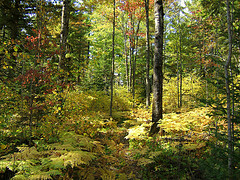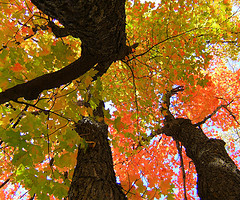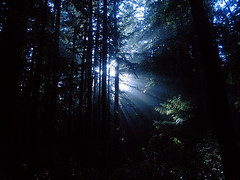Forest Stewardship Program, Reinventing Private Forest Management
By: Amos S. Eno
Posted on:11/23/2010USFS State and Private Forestry is working smarter to meet demand and thinking strategically to conserve landscapes.
At the October 2010 Biomass South conference in Memphis, Ron Bell, President of the Arkansas Association of Resource Conservation and Development Councils, made the point that “private forest landowners with management plans generally take very good care of their land.” They can, he said, be trusted not to over harvest or degrade their own resource.
I agree. The problem is, of the 251 million acres of family forest in the U.S., only 2 in 5 have any kind of plan or professional forestry advice guiding their management. Moreover, 1 in 5 of those acres is owned by people who plan to sell or transfer their forest land in the next 5 years. (Who Owns America’s Forests? Highlights from the National Woodland Owner Survey, USFS, May 2008).
plan to sell or transfer their forest land in the next 5 years. (Who Owns America’s Forests? Highlights from the National Woodland Owner Survey, USFS, May 2008).
That’s why this post is about the Forest Stewardship Program, run out of the State and Private Forestry branch of the U.S. Forest Service and ably headed by Jim Hubbard. The Forest Stewardship Program helps landowners to develop management plans for their forests, a topic that is about as sexy as a tree stump.
Paul Ries, Jim’s Director of Cooperative Forestry, is someone who understands what it means to work smarter with fewer resources. His state programs have already begun making greater use of the internet, and he “gets” what we are doing. He recently referred me to Karl Dalla Rosa, Manager of the Forest Stewardship Program or FSP.
A Gateway to Fiscal Support
The first thing to understand about the FSP is that it is a technical assistance program, not a cost-share program. Money is decidedly more sexy than management planning, so Karl says to keep in mind that “once a landowner has a stewardship plan, he can get access to other programs that do provide fiscal benefits, including state tax abatement programs. The FSP is a ‘gateway’ for access to many federal programs.”
In particular, the following three USDA programs explicitly require FSP plans or their equivalent to disburse benefits:
- Environmental Quality Incentives Program, EQIP, of the Natural Resources Conservation Service
- Biomass Crops Assistance Program, BCAP, of the Farm Service Agency
- USFS Forest Legacy program for support of conservation easements
What about matching requirements? The FSP is administered through the states, and each State Forester has his or her own rul

es, ranging from no match requirement to a fee-based system.
The 2008 Farm Bill explicitly expanded eligibility for many USDA conservation programs to include non-industrial private forest landowners, and the FSP is in most cases the ticket to access those benefits. Karl says they are working hard to ensure that their stewardship plans are as close to “one plan fits all” as possible, so landowners will not have to rewrite plans to qualify for different programs.
A Threshold of SustainabilityAnother important roll of the FSP, according to Karl, is that it serves as a “threshold of sustainability.” Environmental groups with concerns about wildlife and resource depletion “know that when landowners are following stewardship plans, there’s some assurance that all the resource elements on the landscape are being addressed.”
The results of a voluntary survey conducted in 1999 describe how the Forest Stewardship Program meets the needs of landowners:
- Over 80 percent of participants who had written a plan were starting to implement it on the ground.
- Most participants are now using a multi-resource approach to management (for example, the same owner pursuing both timber stand improvement and wildlife protection).
- Over half of the participants have tried new management practices on their land.
Thinking Strategically to Deliver the Vision of a Healthy Forest LandscapeKarl candidly told me of their concern that there was just not enough capacity out there - in their program or the states - to deliver the technical assistance needed “to keep forests as forests on private lands.” The vision is to deliver what’s needed and desired for landowners to take full advantage of all the incentives and tax breaks available to them in the interest of forest health.
Given recent flat budgets, in real terms the program’s capacity has diminished. This, combined with the 2008 Farm Bill mandate for each state to develop a Forest Resource Assessment - a kind of forestry version of the State Wildlife

Action Plans - has led the FSP to think more strategically.
In line with forest resource assessments, the FSP in each state is now focused on priority landscapes. Karl says, “It’s hard to impact habitat working with individual landowners. It’s easier if you’re working with a number of landowners. Then you start to get an aggregate effect.”
He emphasizes that the heart of the program is still to work with individual landowners one-on-one and purely on a voluntary basis. However, Karl foresees a time when certain aspects of Forest Stewardship plans will apply across large areas.
This has the added advantage of lending itself to more effective outreach and engagement of local landowners through mass media and, you guessed it, the internet! In future posts, I’ll introduce you to a program in the Northeast that is serving as the FSP test case for landscape scale stewardship plans.
Dating back to my days at the National Fish and Wildlife Foundation I have felt strongly that State and Private Forestry is the most important program of the Forest Service for the 21st century market. This branch of the agency is the interface with private land owners, consulting foresters and urban forestry. As we move into the 21st century, that’s where the action needs to be.
 Sign In
Sign In
 Sign In
Sign In
